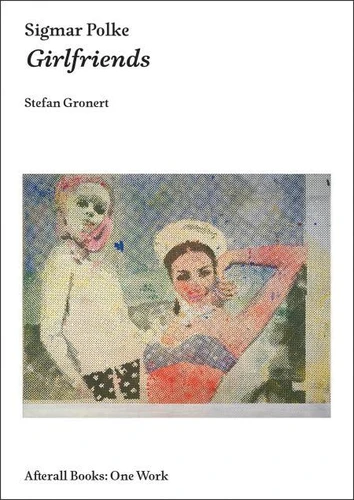Sigmar Polke Girlfriends /anglais
Par :Formats :
Disponible dans votre compte client Decitre ou Furet du Nord dès validation de votre commande. Le format ePub protégé est :
- Compatible avec une lecture sur My Vivlio (smartphone, tablette, ordinateur)
- Compatible avec une lecture sur liseuses Vivlio
- Pour les liseuses autres que Vivlio, vous devez utiliser le logiciel Adobe Digital Edition. Non compatible avec la lecture sur les liseuses Kindle, Remarkable et Sony
- Non compatible avec un achat hors France métropolitaine
 , qui est-ce ?
, qui est-ce ?Notre partenaire de plateforme de lecture numérique où vous retrouverez l'ensemble de vos ebooks gratuitement
Pour en savoir plus sur nos ebooks, consultez notre aide en ligne ici
- Nombre de pages112
- FormatePub
- ISBN978-1-84638-184-3
- EAN9781846381843
- Date de parution13/08/2019
- Protection num.Adobe DRM
- Taille4 Mo
- Infos supplémentairesepub
- ÉditeurAfterall Books
Résumé
An illustrated exploration of Girlfriends (1965/66), one of Sigmar Polke's important early paintings. The artist Sigmar Polke (1941-2010) worked across a broad range of media-including photography, painting, printmaking, sculpture, and film-and in styles that varied from abstract expressionism to Pop. This volume in Afterall's One Work series offers an illustrated exploration of Freundinnen (Girlfriends 1965/66), one of Polke's important early paintings.
Taken from a found image of two young women, and using the raster dots also found in mass media reproductions, Girlfriends offers a statement about the use and social function of images. Stefan Gronert approaches Girlfriends through its deliberate and elusive ambiguity, providing technical detail and historical background that allow some of the work's motivation and depth to become clearer. Gronert analyzes Polke's relationship to his tutors and peers, especially Gerhard Richter; describes the art historical context in which Polke worked; and discusses some of the social and political issues to which Girlfriends refers.
Considering such topics as the distinction between Polke and Alain Jacquet in their use of photographed material, between Polke's use of the raster technique and that of Roy Lichtenstein, and the feminist discourse of the time, Gronert draws on a variety of critical interpretations of Polke's work, including some material that has not yet been translated into English.
Taken from a found image of two young women, and using the raster dots also found in mass media reproductions, Girlfriends offers a statement about the use and social function of images. Stefan Gronert approaches Girlfriends through its deliberate and elusive ambiguity, providing technical detail and historical background that allow some of the work's motivation and depth to become clearer. Gronert analyzes Polke's relationship to his tutors and peers, especially Gerhard Richter; describes the art historical context in which Polke worked; and discusses some of the social and political issues to which Girlfriends refers.
Considering such topics as the distinction between Polke and Alain Jacquet in their use of photographed material, between Polke's use of the raster technique and that of Roy Lichtenstein, and the feminist discourse of the time, Gronert draws on a variety of critical interpretations of Polke's work, including some material that has not yet been translated into English.
An illustrated exploration of Girlfriends (1965/66), one of Sigmar Polke's important early paintings. The artist Sigmar Polke (1941-2010) worked across a broad range of media-including photography, painting, printmaking, sculpture, and film-and in styles that varied from abstract expressionism to Pop. This volume in Afterall's One Work series offers an illustrated exploration of Freundinnen (Girlfriends 1965/66), one of Polke's important early paintings.
Taken from a found image of two young women, and using the raster dots also found in mass media reproductions, Girlfriends offers a statement about the use and social function of images. Stefan Gronert approaches Girlfriends through its deliberate and elusive ambiguity, providing technical detail and historical background that allow some of the work's motivation and depth to become clearer. Gronert analyzes Polke's relationship to his tutors and peers, especially Gerhard Richter; describes the art historical context in which Polke worked; and discusses some of the social and political issues to which Girlfriends refers.
Considering such topics as the distinction between Polke and Alain Jacquet in their use of photographed material, between Polke's use of the raster technique and that of Roy Lichtenstein, and the feminist discourse of the time, Gronert draws on a variety of critical interpretations of Polke's work, including some material that has not yet been translated into English.
Taken from a found image of two young women, and using the raster dots also found in mass media reproductions, Girlfriends offers a statement about the use and social function of images. Stefan Gronert approaches Girlfriends through its deliberate and elusive ambiguity, providing technical detail and historical background that allow some of the work's motivation and depth to become clearer. Gronert analyzes Polke's relationship to his tutors and peers, especially Gerhard Richter; describes the art historical context in which Polke worked; and discusses some of the social and political issues to which Girlfriends refers.
Considering such topics as the distinction between Polke and Alain Jacquet in their use of photographed material, between Polke's use of the raster technique and that of Roy Lichtenstein, and the feminist discourse of the time, Gronert draws on a variety of critical interpretations of Polke's work, including some material that has not yet been translated into English.



